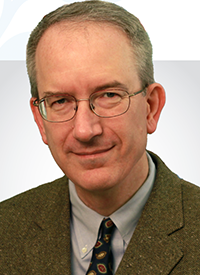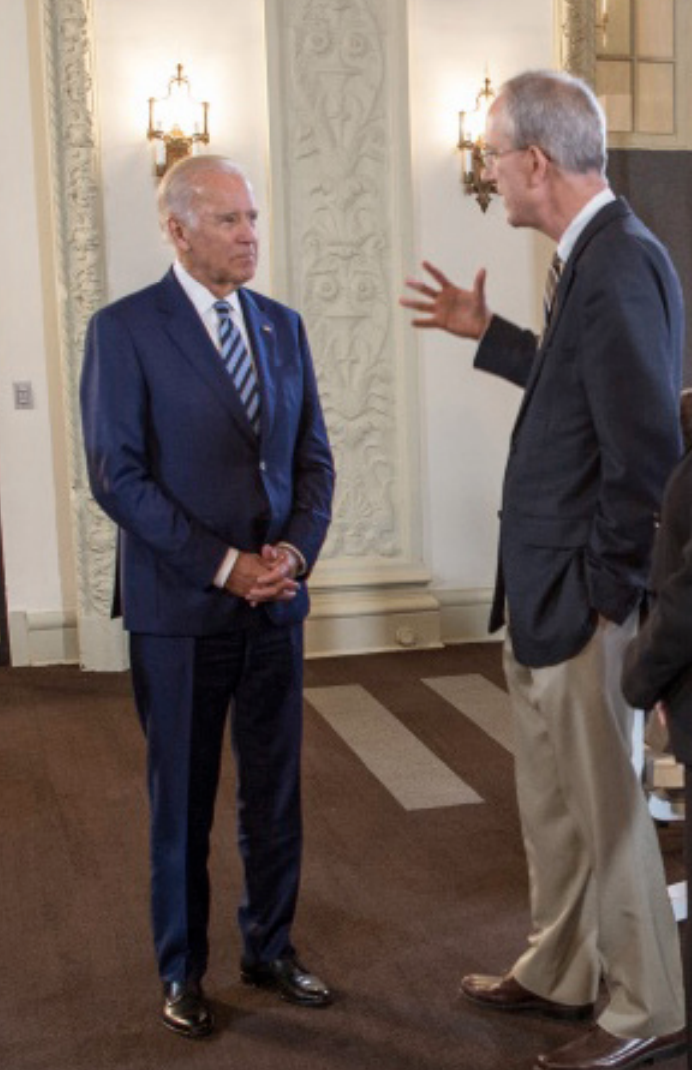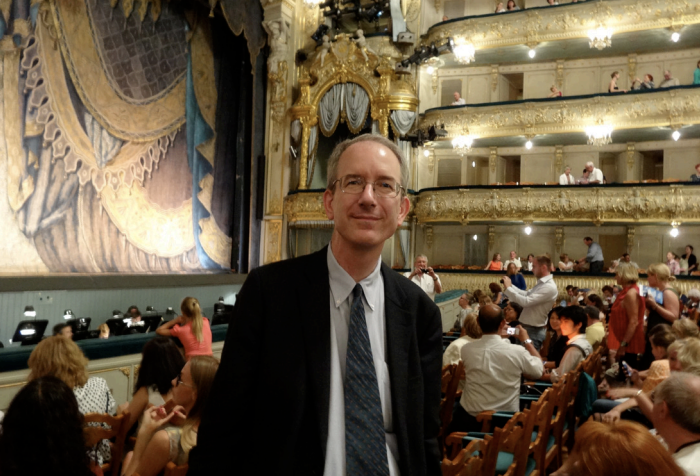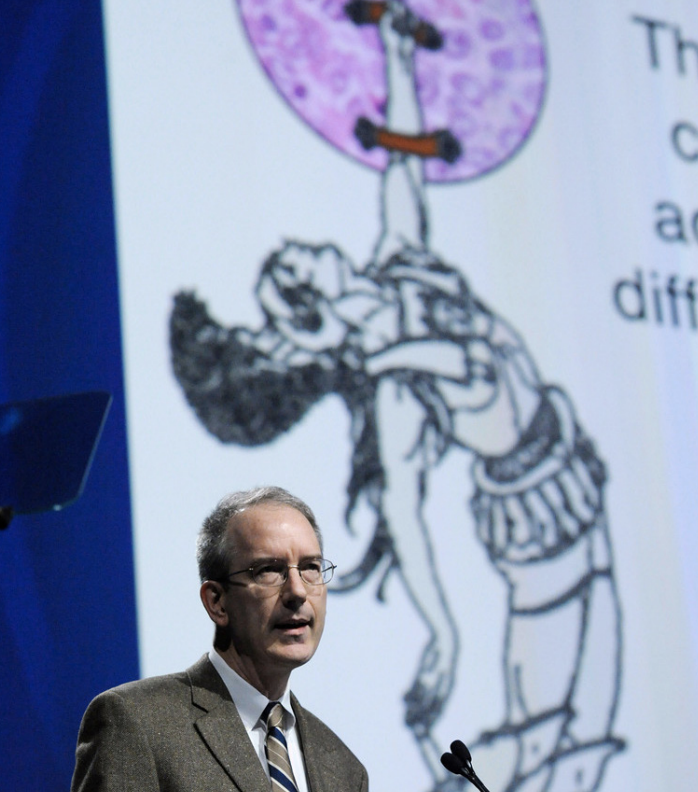Article
For Staudt, a Keen Eye Sparks Opportunities to Dig Deeper
Author(s):
Driven by his twin passions for music and science, Louis M. Staudt, MD, PhD, has made a career out of reading between the notes.
Louis M. Staudt, MD, PhD

Louis M. Staudt, MD, PhD, has an eye for patterns.
As director of the National Cancer Institute’s Center for Cancer Genomics, sometimes the patterns that absorb his mind are gene expression profiles that explain why tumors act the way they do. Sometimes, though, the lifelong amateur pianist is transfixed by the patterns in the music of the great composers.
“If you’re playing a Bach toccata and you’ve played a lot of Bach toccatas before, even if you’re playing [this one] for the first time, you pretty much know what the next group of notes might be,” Staudt said.
In his 4 decades as a scientist, Staudt has made key insights into the genomics of lymphoma and reshaped the way clinicians risk-stratify and treat patients. Many of his greatest discoveries have started with his ability to see the big picture from a small sample.
“Lou is pretty unique in his ability to take a modicum of data that’s not very large and make the observation from the data that is the most salient, most important thing,” said Ash Alizadeh, MD, PhD, a former student and longtime collaborator of Staudt’s.
Deviating From Expectations
If his ability to identify patterns has played a major role in Staudt’s career, that career was only possible because of his willingness to deviate from what appeared to be his logical next step after college.
Staudt grew up in Michigan, where his mother was a nurse who ran the operating room at the Children’s Hospital of Michigan and his father was a physician for the Chrysler Corporation.
“He would do an occasional house call with Lee Iacocca,” Staudt recalled.
As a child, it was obvious that Staudt inherited some of his parents’ interests. His love for math and science was evident from an early age. “I’m not ashamed to say I was a nerd,” he said.
He was also into music. When he got to Harvard University, he likes to say, he “majored in Glee Club.” In truth, he majored in biochemistry, although his role as president of the famed choral group took up much of his time and his fellow singers comprised much of his social circle, he said.
After college, though, Staudt faced a choice. He wanted to go to graduate school, but he was not sure whether to follow his parents’ path and enroll in medical school or pursue a career in the laboratory. His parents, not surprisingly, had a strong preference. “They were like, ‘You’ve definitely got to go to medical school,’ ” he said, remembering that his dry creaction was, “ ‘Yeah, no kidding!’ ”
Staudt makes a point to then-Vice President Joseph R. Biden following the announcement of the NCI Genomic Data Commons project in 2016.

Also, during his time at Harvard, Staudt had been introduced to the rapidly changing field of immunology. He was hooked. “Science is a little bit like an addiction,” he said. “When you get a good result, you just crave the next good result.”
Still, Staudt said, since he remained torn between jumping fully into science or following the path of his parents, he decided to “hedge” by enrolling in a joint MD/PhD program at the University of Pennsylvania. Walter Gerhard, MD, Staudt’s graduate mentor, had no such ambiguity about Staudt’s future.
“I always thought he would remain 100% in science,” he said.
Early Breakthroughs
At Penn, Staudt began working on the influenza virus, looking at ways that monoclonal antibodies could neutralize it. “That was the basis of my thesis, but just almost by luck, I stumbled across what turned out to be an important aspect of the diversification of immune responses,” he said.
What Staudt “stumbled upon” was somatic hypermutation, the rapid mutation of immunoglobulin genes that helps explain the diversity of responses to the influenza virus.
Gerhard said the discovery of somatic hypermutation showed “that the antibody response of mice to a hemagglutinin molecule of influenza virus was very diverse. Different individuals responded in quite different ways.”
Gerhard said Staudt was successful because he was extremely organized. Well, mostly. “You wouldn’t have thought that if you would have seen his backpack, which was kind of full of loose papers,” he said of his star pupil.
Looking back, Gerhard said that early influenza research showed a skill set that would prove important in some of Staudt’s later work, analyzing genes associated with diffuse large B-cell lymphoma (DLBCL).
“I think what he did with tumor research helped him in his subsequent work,” Gerhard said. “To do that work without making a mess required a lot of organization, and he was very good at that.”
After graduate school, Staudt did a postdoctoral fellowship with Gerhard at the Wistar Institute, in Philadelphia, and then an internship in internal medicine. He credits the internship with helping him to understand the practical considerations of a clinician, which in turn has helped him design feasible clinical trials.
Zeroing in on Lymphoma
Staudt then joined the Whitehead Institute, working in the laboratory of David Baltimore, PhD, where the focus was on trying to figure out which transcription factors were particularly important in controlling the transcription of genes related to lymphoma. Most of the factors the researchers were examining were commonly found in other types of cells. Then, Staudt observed a transcription factor called Oct-2 seemed to be found only in lymphoid cells.
“That seemed to also open up the possibility that a set of regulatory factors is specific for a stage of B-cell differentiation, and that [these factors] were why the B cell has the properties that it does,” he said.
Staudt was among the first to recognize the potential of genomic analysis to identify new cancer types, therapeutic targets, and biomarkers.

It would take 3 more years to identify the gene that was encoding the transcription factor, thereby confirming that there was a lymphoid-specific expression pattern. That work led Staudt to the National Institutes of Health—the National Cancer Institute, specifically, which he joined in 1988. There, Staudt continued his quest to find genes that were expressed only in lymphoma cells.
“What I really yearned for was a way to study all the genes, every last one in the genome,” he said.
Back then, that level of analysis was not on the radar of most people in the field. Stanford University’s Patrick O. Brown, MD, PhD, however, was among the relatively few investigators in the world who shared Staudt’s interest in unlocking the genome. (Brown, incidentally, went on to become the founder and CEO of Impossible Foods, a leading producer of plant-based meat products.)
Brown had developed the DNA microarray, a way to look at the transcription levels of thousands of genes at the same time. A friend of Staudt’s came back from a visit to Stanford and told him about the invention.
“So the very next day, I cold-called Pat—I had never met him before—and explained my interest,” Staudt said. “And Pat, being the really open, inquisitive guy that he is, just said, ‘Great! Let’s do something together.’ ”
Staudt and his team discovered that DLBCL, thought to be 1 disease, was actually 7 distinct maladies.

Alizadeh, now a professor at Stanford, worked with Staudt and Brown to develop what they termed the “Lymphochip,” a DNA microarray heavily enriched for genes that were expressed in normal and malignant B cells. Alizadeh noted that, at the time, the human genome had not yet been fully sequenced.
“We had bets about how many genes were in the genome,” Alizadeh said. “Most people guessed around 100,000. The first lympho-chip had 6000 genes, so investigators assumed they had about 5% or 6% of the genome. It ended up being about a third of the genome.”
The work they were doing in Staudt’s lab was painstaking and time-consuming, requiring great accuracy, diligence, and persistence. Alizadeh said he does not think Staudt and his other colleagues realized how big of a project they were embarking upon.
“But I also think that he was really looking toward a new chapter, and a new kind of science,” Alizadeh said.
When the team began to study DLBCL tumors using their lympho-chip, they began to see distinct expression patterns. “But it wasn’t just that we found a pattern,” Staudt said. “It was that we found a pattern that related each of the tumors to a different stage of normal B-cell differentiation.”
This was the discovery that would lead to an important realization: What had been thought of as a single disease, DLBCL, was actually 2 molecularly distinct diseases, germinal center B-cell– like DLBCL and activated B-cell–like DLBCL. The finding helped investigators realize that the 2 subtypes responded differently to chemotherapy. Eventually, Staudt and his colleagues identified 7 distinct DLBCL subtypes.
Staudt was president of Harvard’s Glee Club and says he is a good amateur piano player. Performance anxiety killed any chance for a career in music.

“That has led to therapies that work better in one [subtype] than in the other, and to the whole idea of precision medicine,” Staudt said.
Staudt would go on to demonstrate that survival following chemotherapy among patients with DLBCL correlated with molecular features. These findings had applications across other malignancies, including chronic lymphocytic leukemia (CLL), mantle cell lymphoma (MCL), and follicular lymphoma.
Staudt has continued in his work, in terms of both expanding knowledge of the subtypes of DLBCL and helping to develop therapies. His team discovered the nuclear factor (NF)- κβ pathway as a therapeutic target, and showed that its activation depends on chronic activity of B-cell receptors in lymphomas. He discovered that drugs like ibrutinib (Imbruvica) that inhibit B-cell receptor-dependent NFκβ signaling were killed malignant B-cell lymphoma cells. Ibrutinib is currently approved for use in patients with MCL, CLL, Waldenström macroglobulinemia, small lymphocytic lymphoma, marginal zone lymphoma, and chronic graft-vs-host disease.
Staudt outside the world-famous Louvre Museum in Paris, France

Alizadeh said Staudt helped transform cancer medicine because he visualized the power of genomic analysis. While genetic characteristics like HER2 or EGFR expression were already being used, Staudt realized that a wider lens could magnify the insights.
“To [see] that extending this to the genome [would] help build a taxonomy of cancer and discover new cancer types—that was visionary,” Alizadeh said.
The Notes and the In-Between
Staudt lives with his wife, the poet and scholar Kathleen Henderson Staudt, PhD, outside Washington, DC. They have 2 grown children, a son who trained as a pediatric cardiologist and is now working on translational research, and a daughter who is an attorney who has fought to reform bail laws in Illinois.
Staudt said that his work at NCI consumes most of his time, but that he loves to read in his rare free moments. This summer, he was reading the book Behave: The Biology of Humans at our Best and Worst by Stanford neuroscientist Robert Sapolsky, PhD.
“He goes right down to the basic science of neurotransmitters, to which parts of the brain do what,” he said. But, he added, Sapolsky also zooms out to explain the connection between that basic science and the behaviors that impact society and the planet, translating the basic science to reveal its real-world impact.
Staudt’s discovery that survival in DLBCL correlated with certain molecular features revolutionized treatment across multiple other malignancies.

In fact, much of what Staudt reads is nonfiction. He likes biographies of great individuals, particularly of great scientists, he said. “The last fiction book I think I read was Dune,” Staudt said. “I read it because I wanted to see the movie.”
Staudt also makes sure music is a part of his everyday rhythm. He plays the piano daily and considers himself a “very good amateur.” However, don’t expect a Staudt recital any time soon. These days, he simply plays for his own enjoyment. “When I was younger, I did try to give recitals,” he said. “I would routinely forget things and freeze, and it was really ugly.”
Although Staudt has built a career out of finding patterns in science and math, he said that one thing he loves about music is how it transcends the mathematics of rhythms and notes.
“It’s also this vaguer, important emotional content that comes in ways that you can’t really specify,” he said. “That really is a big part of why you play music. It’s not just another form of mathematics.”
Indeed, Staudt said part of his work as a scientist is also about the interplay between the patterns and the broader picture. He recalled being nervous when he was about to publish his first paper, wondering if he had studied enough cases to back up his findings.
“I knew full well that even though it was statistically significant, the thing could fall flat on its face,” he said. “But my approach has always been, let’s just wrestle this to the ground. Let’s just keep on seeing whether it’s true.”








